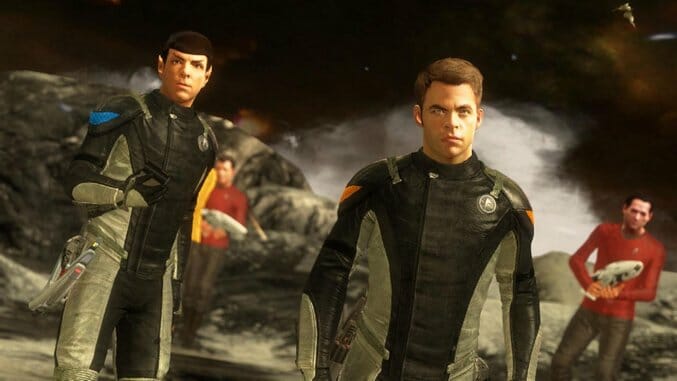Star Trek (Multi-Platform)

Right off the bat: I am not the proverbial unbiased reviewer. I’ve been disappointed with Star Trek videogames for the last two decades, since Interplay’s 25th Anniversary adventure game and its sequel Judgment Rights basically did it “right,” creating what amounted to an additional season to the original series. Since then, the brand has seen multiple companies, including Bethesda and Activision, attempt to create something workable from over forty years of stories set in the same universe to varying degrees of failure.
The 2009 cinematic reboot of the franchise was enough of a success that it was a given that someone would get that license and do something with it. With Mass Effect owing something of a debt to Star Trek when it came to world-building and presentation, it made sense that Bandai-Namco would look to those games when it came to telling stories with Kirk and crew. The first screens gave me genuine hope—was I going to finally get to play a good Star Trek game on my Xbox?
I really shouldn’t let myself get excited about these sorts of things. In an attempt to recapture the momentum of the Abrams flick, Star Trek quickly jettisons all pretense of being about anything more than murdering aliens and solving incredibly simple puzzles. It’s almost galling that doesn’t even do either of those with any sort of competence.
While a lot of people may joke about the lens flares and shininess of the new films, it’s easy to see why they attracted an audience. It’s the first time that a big-screen Trek film has been shot with any eye for visual excitement, and that’s the first clue that players get that the game is just not going to measure up. Graphically, certain elements stand out as being well-tailored (the Enterprise’s interiors are rendered well, for example, and the space scenes are pretty neat) but character animations are rarely better than tolerable and frequently slide into the grotesque.
In fact, the sheer number of glitches and oddities made Star Trek feel like it was still in alpha a lot of the time. More than once, my partner in combat disappeared and reappeared in the middle of a firefight and I saw the inner workings of Kirk’s head a little too often thanks to a wonky camera.
The same thought put behind the camera was obviously applied to the controls, which feel primarily designed to kill the player’s character as often as possible. Latency and movement issues make it feel like you’re playing the game in another room, and this carries over to the too-frequent puzzle elements, making them even more frustrating and dull. This isn’t to say it’s all bad when it comes to moving Kirk or Spock and interacting with the environment—the game is willing to cheat to keep you from dying during platform elements.
Much PR hash has been made of the “bro-op” gameplay, and the first time you ask Spock for a boost so you can access a crawlspace is pretty neat. For the most part, though, your partner is either tripping over you or far away at any given time. In fact, the game’s focus on Kirk and Spock is a huge detriment to the overall experience. The 2009 movie did a nice job of giving every character a moment or two that showed off their skills and personality. In this game, everyone who is not Kirk or Spock are given short shrift, with one very funny exception involving Bones leaning out of a shuttlecraft with a rifle. Simon Pegg is easily the best of the supporting actors, hamming it up just enough to make up for the fact you can’t see him making comic expressions while actors like John Cho and Anton Yelchin are woefully underused. While most vocal performances seem to at least try to capture a bit of what made them work on the screen, Zoe Saldana is so deadpan that you get the impression that she’s playing April Ludgate In Space instead of the witty, passionate version of the character we saw on film.

